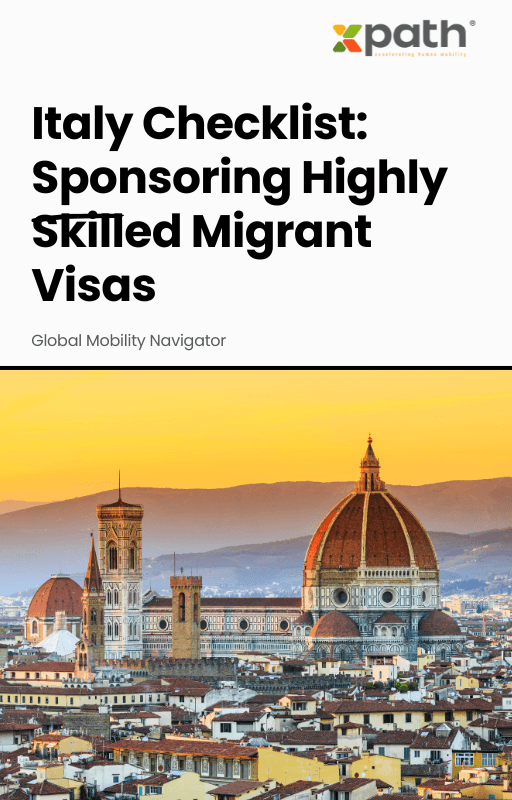Italy Checklist: Sponsoring Highly Skilled Migrant Visas
Grab a copy of a guide to international employee relocation
View E-bookLet’s face it: Today’s companies aren’t just leapfrogging across markets for opportunity—employees are crossing borders, time zones, and even cultures at lightning speed. But with this massive movement comes complexity, and technology is supposed to be the map that guides you through the chaos. The catch? Implementing global mobility solutions isn’t as simple as flipping a switch. Many organizations have stumbled into avoidable traps that stall progress, sow confusion, or ultimately end with expensive do-overs. To prevent your company from joining those ranks, let’s unpack exactly how to sidestep these common hurdles and get your mobility tech humming along the fast lane.
Global mobility is more than just relocating employees—you’re talking about integrating compliance, payroll, tax, travel, benefits, and so much more for workers all over the world. Remote work and hybrid models are now mainstream, with over 53% of organizations worldwide offering some form of flexibility. Technology platforms like xpath.global have become essential, bundling everything from vendor management to immigration services under one roof. But the risk of rolling out a shiny new system is very real unless you’re clear on your goals, processes, and employee needs from day one.
According to a 2023 Mercer report, 65% of organizations listed “integration with existing systems” as the single biggest headache in mobility tech adoption. Another EY survey found that 49% underestimated the complexities of data privacy across jurisdictions, leading to compliance nightmares and eroded trust among global assignees.
Case in point: A tech giant made headlines when its ambitious mobility rollout stalled, thanks to fragmented data—HR, payroll, and travel teams worked in siloes, resulting in manual errors, double payments, and, worst of all, unhappy expats. Sounds familiar? It’s not uncommon, and it’s avoidable.
As tempting as it is to focus on fancy features, the beating heart of any successful global mobility solution is people. Companies often fail to get key stakeholders on board—HR, IT, payroll, finance, and even relocating employees themselves. According to Deloitte, only 36% of global mobility programs involve end-users in the design or pilot stage. What happens then? Resistance, confusion, and under-utilized technology.
Imagine launching a new platform, only to find employees sticking to spreadsheets and emails because they weren’t trained—or worse, no one told them why the change was happening. The only thing global about that exercise is the frustration shared across offices!
Let’s talk data. With more borders come more rules—GDPR in Europe, HIPAA in the US, and countless local privacy laws. A misstep here isn’t just an IT glitch; it can mean six-figure fines and reputational damage. One multinational retailer learned this the hard way when an unvetted system exposed sensitive data of hundreds of overseas workers, prompting not only regulator scrutiny but also a severe dip in employee trust.
This is where solutions like xpath.global shine. They’re built with robust compliance frameworks and customizable roles, allowing companies to tailor access without sacrificing security. Don’t just tick the compliance box. Address it proactively, involve legal and security experts early, and demand transparency from vendors.
For most, the holy grail of mobility technology is seamless integration—pulling data from legacy HRIS, syncing with payroll, linking with travel and relocation vendors, and reporting on it all. Yet in reality, 3 out of 5 companies still rely on manual workarounds for critical steps, based on a 2023 AIRINC survey. Why? Poor planning, unclear objectives, and assuming IT can “just make it work” after the fact.
Savvy organizations map their existing processes, pinpoint must-have integrations, and choose providers with open APIs and ecosystem partners. Platforms like xpath.global offer marketplace models, giving you access to vetted suppliers who play nicely together—no more data dead-ends.
How do you dodge these pitfalls? Simple steps, big impact. Start with crystal-clear goals: What problems should the technology solve, and for whom? Document workflows, current pain points, and expectations. Pilot before you scale—get feedback from real users. Invest in change management and training. Measure success not by system uptime, but by employee satisfaction and admin time saved. And always, always, build in flexibility for your future needs.
There’s never been a more exciting (or challenging) time to run a global mobility program. Whether you’re moving five people or five thousand, technology can be your best friend—or your biggest hurdle. By understanding the most common pitfalls, involving your people, safeguarding your data, and selecting the right platform, you can build a flexible, scalable mobility operation that turns complexity into competitive advantage. The future of global talent is borderless. Is your tech ready to keep up?
Q: How do I ensure my global mobility tech integrates with my current HR systems?
A: Start by choosing a platform with open APIs and documented case studies of successful integrations. Platforms like xpath.global are designed for interoperability and offer support during onboarding.
Q: What’s the biggest compliance risk in global mobility?
A: Data privacy is typically the top challenge. Ensure your provider complies with major regulations like GDPR and allows country-specific customization for legal compliance.
Q: How can we encourage employees to adopt new mobility technology?
A: Involve them early in the process, prioritize intuitive UX, provide thorough training, and show how the platform will make life easier for everyone involved.
Q: Why do global mobility tech projects fail?
A: Common reasons include poor planning, lack of stakeholder buy-in, limited customization, inadequate change management, and ignoring data integration challenges.
Q: How can xpath.global support my global mobility strategy?
A: xpath.global simplifies vendor management, centralizes compliance and documentation, and supports customizable workflows to fit organizations of all sizes and industries.
Ready to transform your mobility program? Explore xpath.global’s solutions.

Italy Checklist: Sponsoring Highly Skilled Migrant Visas
Grab a copy of a guide to international employee relocation
View E-book